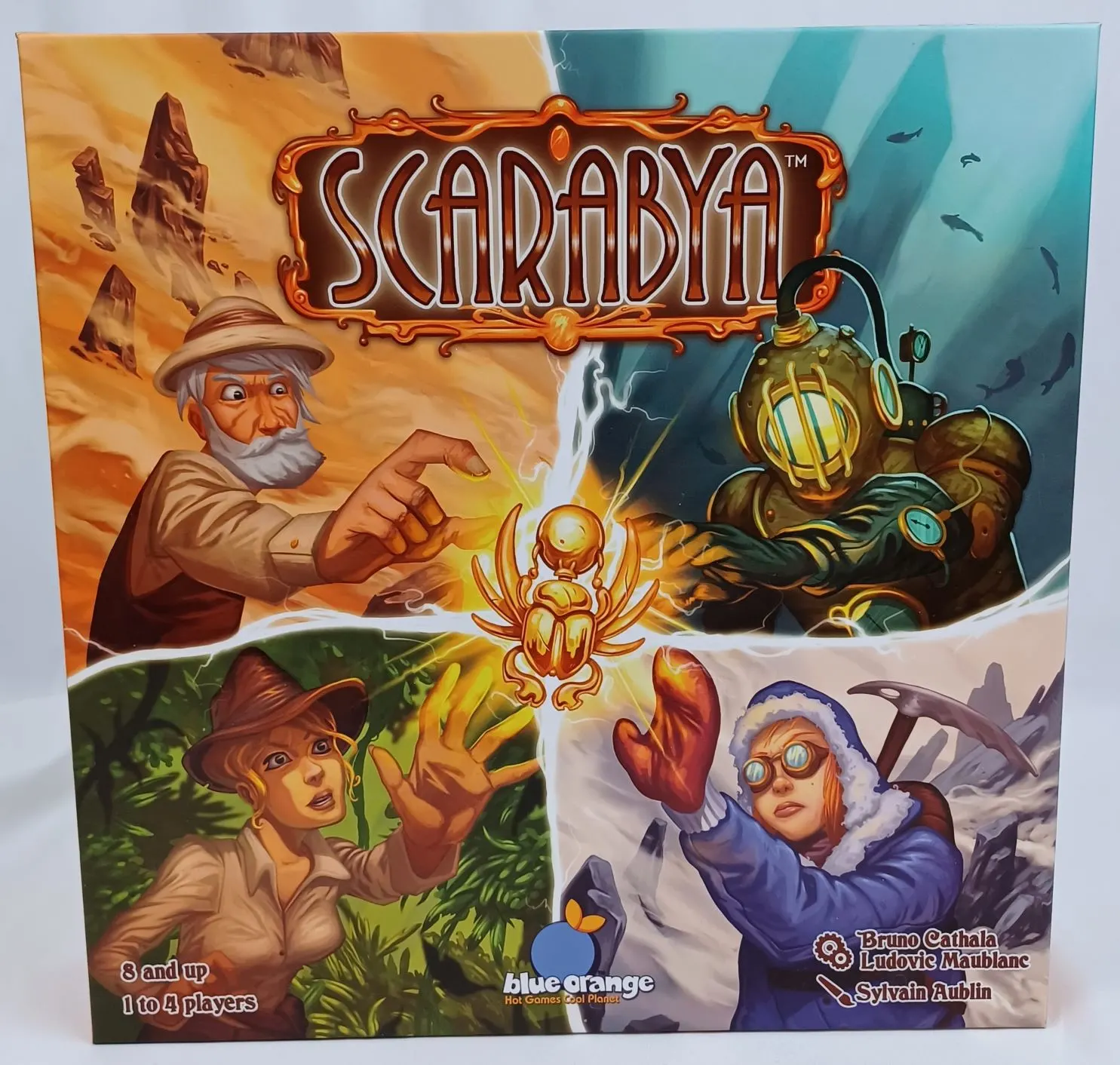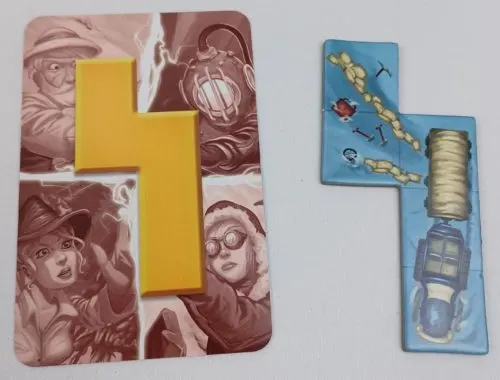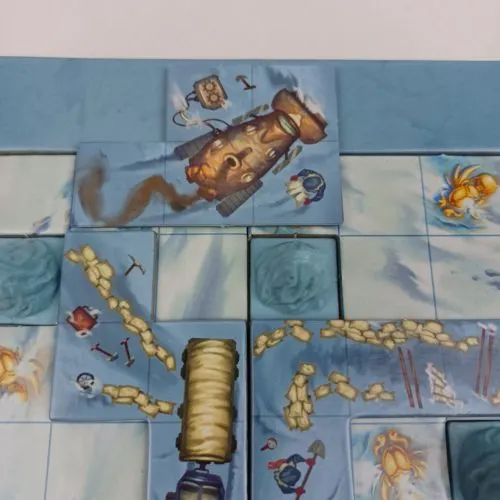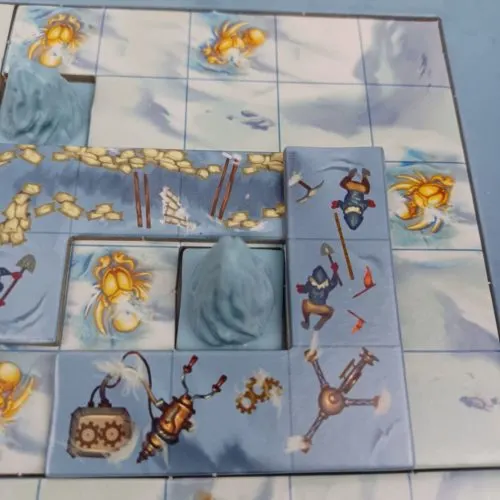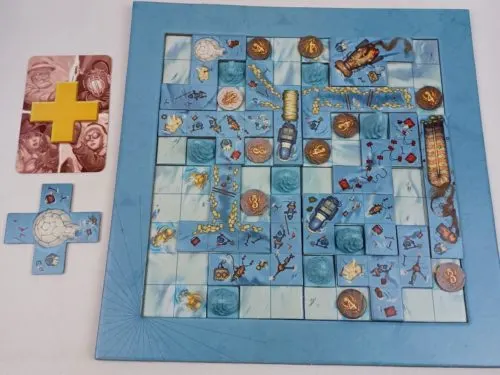Bruno Cathala is arguably one of the most acclaimed board game designers of all time. He has helped create a lot of well loved board games including one of my own personal favorites Kingdomino. Generally whenever I see a game that he created/helped create, I take notice. This is one of the first things that intrigued me about Scarabya. On top of this the game is a tile laying game which is a genre that I generally enjoy. For these reasons I was excited to check it out after I was able to pick up the game on clearance. Scarabya is mostly a solitaire game and may not be the most original game, but it is still a fun little tile placement game that fans of the genre should really enjoy.
How to Play Scarabya
Setup
- Each player chooses a color and takes the matching components:
- Frame
- 4 Boards
- 12 Tiles
- 8 Rocks
- The youngest player becomes the Great Explorer. They are responsible for shuffling the Mission Cards and turning them over throughout the game.
- Place the Scarab Tokens in the middle of the table where everyone can reach them.
- The Great Explorer will take their four Boards and assemble them inside their Frame how they desire. The other players will place their Boards inside their Frame in the same way so everyone’s final boards look the same.
- All of the players will place their Rocks inside the holes in the board.
Playing the Game
The game is played over twelve rounds.
Each round begins with the Great Explorer turning over the top card from the Mission Card deck. The card will feature one of the twelve tiles. Each player will use the corresponding tile in this round.
Each player will place the Tile on their board following the placement rules detailed below.
After everyone has placed their Tile and scored any Scarab Tokens, the next round is played.
Placing Tiles
The first tile each player places on their board must cover at least one of the four squares in the center of their game board.
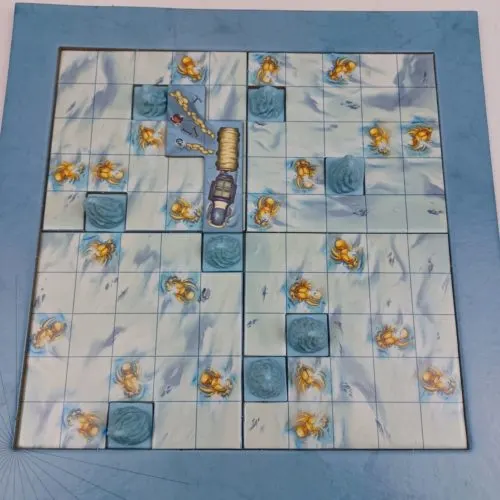
The blue player has placed their first tile on their board. The tile touches one of the four center spaces so it was placed correctly.
After the first tile, all additional Tiles must be placed where at least one of its squares touch the edge of at least one square of a Tile that has already been placed. Diagonals do not count.
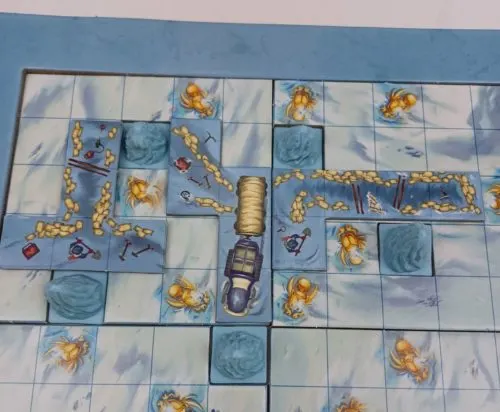
In this picture two tiles have been placed after the first tile in the middle was placed. The tile on the right was placed correctly as it touches one of the edges of a previously placed tile. The tile on the left was placed incorrectly as one of its edges didn’t touch a tile that had already been placed.
Other rules that must be followed while placing Tiles are as follows:
- The whole Tile must be placed within the Frame.
- Tiles can be placed around the Rocks but not on top of them.
- Two Tiles may never be placed on top of one another.
- You can place Tiles on top of Scarab Symbols, but you won’t score any points for those spaces.
- If a Tile can be placed somewhere on your board, it must be placed even if it hurts you.
- If a Tile cannot be placed on your board, it is discarded.
Earning Scarab Tokens
As you place Tiles on your game board, you will start to create Excavation Areas. Excavation Areas are sections of the board that are completely surrounded by either placed tiles, Rocks, and the edges of the game board. These areas may only consist of up to four squares or less.
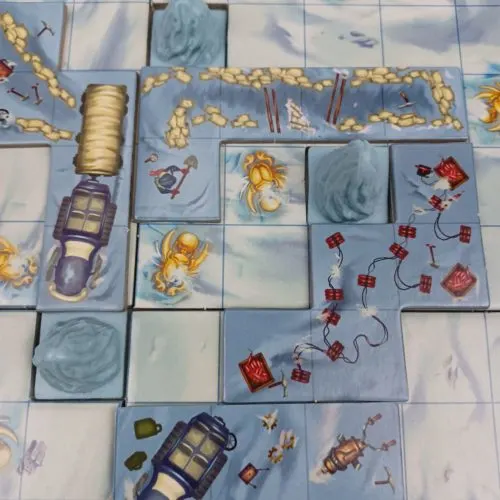
The blue player has created an Excavation Area of four squares between the Rocks and tiles that they have played.
When you have created an Excavation Area you will check to see if any Scarab Symbols are inside the area. For each Scarab Symbol inside the Excavation Area, you will earn a Scarab Token worth points equal to the number of spaces in the area. You will place these tokens on each Scarab Space. If the corresponding Scarab Token is not available, you can take lower valued tokens that add up to the missing value.
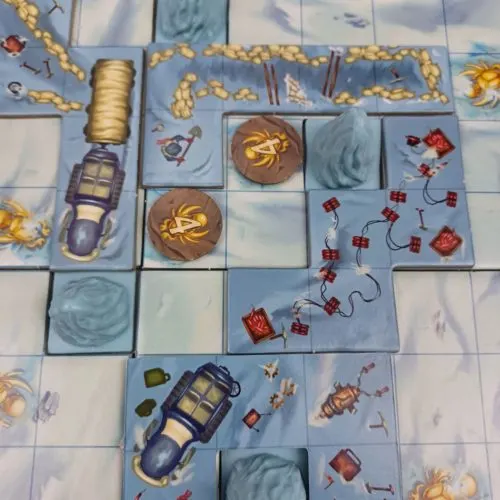
As the Excavation Area consisted of four squares, a four point token will be placed on both of the Scarab Symbols inside the Excavation Area.
End of Game
The game ends after the twelfth round (all of the cards have been drawn and all tiles have been played).
Each player will count up the value of all of the Scarab Tokens they collected during the game. The player that has collected the most points, wins the game. If there is a tie, the tied players share the victory.
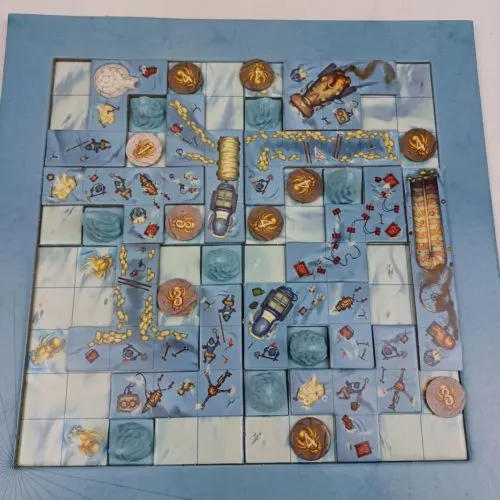
This is the blue player’s board at the end of the game. Some of the Scarab Symbols weren’t scored because they weren’t inside an Excavation Area. This player has scored 34 points in the game.
Variants
One on One
In the One on One game two players will play on the same game board instead of creating their own.
The players will take turns flipping over a Mission Card and placing the corresponding Tile. All placement rules are the same as the main game.
When you create a Excavation Area, you will take any Scarab Tokens that you earn. An unused Scarab Token will be placed in the Excavation Area to indicate that it has already been scored.
If a Tile can be placed it must be placed. If a Tile cannot be played, the current player keeps drawing new cards until they get a Tile that they can place.
When all of the Tiles have been placed/discarded, the game ends.
If the second player has not had the opportunity to play as many Tiles as the first player, they will receive one point for each Scarab Symbol not in an Excavation Area. Each player will tally their score with the player scoring more points winning the game.
Solo
The objective of the Solo game is to cover up all of the Scarab Symbols to prevent any of them from being scored in an Excavation Area.
The gameplay otherwise plays the same as the main game.
If you can play a Tile, you must play it.
At the end of the game, if you successfully cover up all of the Scarab Symbols, you win the game.
My Thoughts on Scarabya
At this point I am not sure how many tile placement games that I have played and reviewed here on Geeky Hobbies. It has probably been quite a few though. It might not be my favorite genre, but it is near the top. I bring this up since Scarabya is a tile placement game to its very core.
The basic goal of the game is to divide up the board into small sections by placing tiles onto the board. The ultimate goal is to create sections with Scarab Symbols trapped inside. You want to make each of these sections as close to four squares as possible without going over. The order that you place the tiles is determined by which card is drawn. Each player has their own board (all setup in the same way) where they are trying to maximize their points. The player that scores the most points ultimately wins the game.
On the surface Scarabya seems like a simple game and in many ways it is. If you have ever played a tile placement game before, you will probably be able to jump right into Scarabya. Even those who aren’t that familiar with the genre shouldn’t have too much trouble with the game. Basically you just try to place the current tile on your board in a way to create small sections that also contain Scarab Symbols. The game could be taught to new players within minutes and players should be able to jump right in and know what they are supposed to try and do.
On top of this Scarabya plays really quickly. It is basically the very definition of a filler game. I would estimate that most games will only take 15-20 minutes and could even go faster once players are more familiar with the game. If the players have to analyze every single option, it may take a little longer. This seems like the perfect length for the game as it is just long enough where you have time to implement a strategy without it drawing out for too long. The short length makes it a perfect game for when you don’t have much time, need an easier game to play between more complex games, or even when you want a game that you can easily get a rematch in right away.
With the game being on the simpler side you always have to wonder how much strategy there is to the game. I wouldn’t say that Scarabya has a ton of strategy, but it has plenty for what type of game that it is trying to be. The player with the best strategy is going to win most of the time. There is a little reliance on luck as the order that the tiles are played could have an impact on the strategy that you are trying to implement. A tile could get chosen that works horribly with how you have placed your tiles, messing up your strategy. Since everyone plays with the same board and the same order tiles though, the better strategy will win most of the time as everyone plays under the exact same circumstances.
The strategy in Scarabya is pretty interesting. The ultimate goal of the game is to maximize your points. To do this you want to try and get Scarab Symbols into sections that contain exactly four squares as that will maximize your number of points. This is especially true if you can get two or more of the symbols within the same section. While this is the best case scenario, you have to balance it against the fact that you don’t want to get into a situation where a section ends up too large where it doesn’t score any points. While you should try to go for four points per symbol in a couple areas on your board, you also need to be willing to take points where you can get them instead of losing out on getting any points for a symbol. This creates an interesting trade off between risk versus reward as you can’t play too risky or risk adverse.
People that require a ton of strategy in their games, may think Scarabya is too simple. I think the game creates a really good balance though. Your decisions truly matter in the game as each tile you place impacts where you can place tiles in future rounds. There are decisions to make each round which truly matter. The game puts in some limitations though as there are only a certain number of options each round to consider. This helps keep down potential analysis paralysis as you can take your time thinking about how you want to place your next tile, without having to consider every potential placement.
Basically Scarabya fits perfectly into the light to moderate strategy spectrum of games. This leads to a fun game that the whole family can enjoy. The game finds a good balance between making you feel like your decisions matter without being bogged down by strategy where it takes forever to ultimately make a decision. For this reason I think Scarabya will work well as a family game and as a sort of gateway game for people that don’t normally play a lot of board games.
I genuinely enjoyed playing Scarabya. I wouldn’t consider it to be one of my favorite games of all time, but I had fun with it and plan on coming back to it every so often. If someone else wanted to play the game, I would have no problem joining in. All that said the game does have a couple issues which keep it from being a perfect game.
Possibly the biggest problem with Scarabya is the fact that there is basically no player interaction in the main game. Outside of comparing scores at the end of the game, you could play the game with one to four players and the experience wouldn’t change all that much. Nothing any individual player does has any impact on the other players. As everyone uses the same board and uses the tiles in the same order, it pretty much becomes a game of who plays their tiles the best. Playing the game solo hoping to improve your high score doesn’t feel much different than playing against other players.
This is going to be a bigger problem for some players more than others. While I would have liked a little more player interaction, I personally didn’t find it to be a huge issue for the game. Others are going to wonder what the point is playing with other players if it has no real impact on the actual gameplay. Both are valid opinions. Basically if you are looking for a game with at least a decent amount of player interaction, you are going to be disappointed by Scarabya. If you don’t mind more solitaire games, I don’t think you will have much of a problem with this part of the game.
Other than the game not having a lot of player interaction, the biggest issue with Scarabya is the fact that I wouldn’t consider it to be the most original game. I enjoyed the game quite a bit as it is a good tile laying game. At the end of the day though, I wouldn’t say it is particularly innovative in any meaningful way. I have played quite a few different tile placement games before, and Scarabya seems pretty similar to several of them. If you have never played a similar tile placement game before, this shouldn’t be a problem for you. If you already own a similar game though, I don’t see the game really offering anything new that will spark your interest more than other similar games.
The final issue I had with the game has to deal with the components. The components aren’t terrible, but I don’t think they quite live up to the normal standards of Blue Orange Games. The artwork is pretty good and the tiles are made of thick enough cardboard where they should last. The plastic rocks are pretty nice as well even if they are only decorative. I had two main issues with the components. The first is that I wish there were more boards so there could be more potential game board combinations. You can create quite a few different combinations, but a few more boards would have added even more variety to the game. The biggest problem involves the frames. The problem is that the frames are too small where when you try to place the boards inside them, they are too tight where you end up with a curved board. Ultimately I found it easier to just play without using the frames as they created more problems than they solved.
Should You Buy Scarabya?
Ultimately I had fun playing Scarabya and think it is a pretty good game with a couple flaws keeping it from being a fantastic game. For the most part the game is a pretty simple tile placement game. The ultimate objective of the game is to place tiles on your board to create sections of four squares that feature one or more Scarab Symbols. If that sounds simple, it should as the game is quite easy to learn and play. It also plays quickly making it a good filler game. The game has strategy to it though where the decisions you make are going to play the biggest role in if you ultimately win the game. I think the game finds a good balance where it is a fun game that the whole family can enjoy. It basically doesn’t have much player interaction though where it sometimes feels more like a solitaire game where players only end up comparing scores at the end. The game is also not the most original as it is similar to quite a few other tile placement games. The component quality could be a little better in some areas as well.
Ultimately my recommendation for Scarabya comes down to your thoughts on simpler tile placement games. If you generally like more strategic games, don’t generally like tile placement games, or already own quite a few games from the genre; I don’t know if Scarabya offers enough to make it worth your while. If you are looking for an accessible and yet still fun tile placement game though, you should enjoy Scarabya and should consider picking it up.
Buy Scarabya online: Amazon, eBay
. Any purchases made through these links (including other products) help keep Geeky Hobbies running. Thank you for your support.

